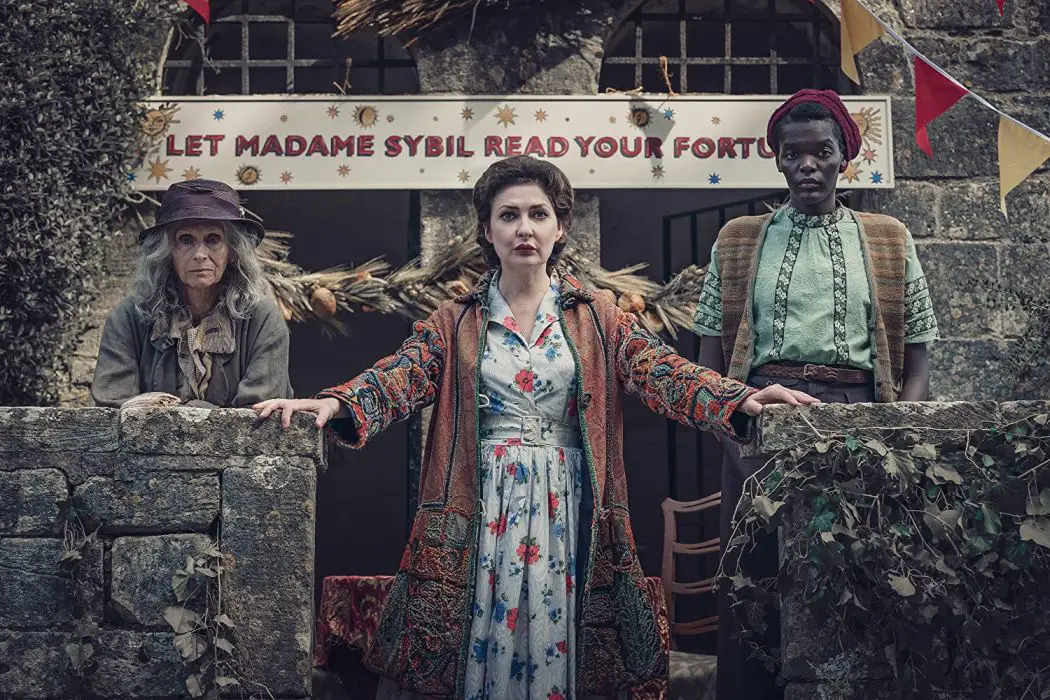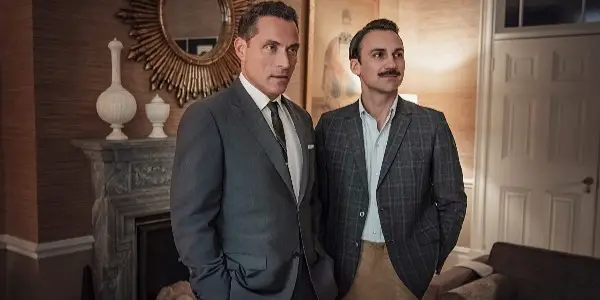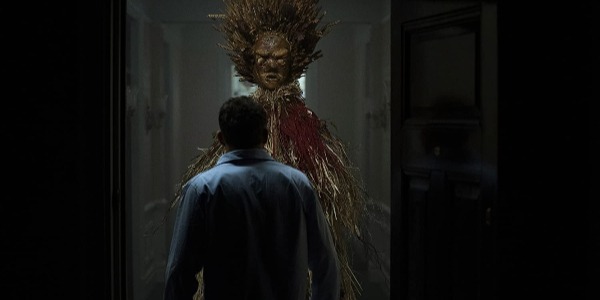THE PALE HORSE Miniseries: More “Midsommar” Than “Midsomer Murders”

Film critic, Ithaca College graduate, University of St Andrews masters…
Agatha Christie’s The Pale Horse, though not quite a detective story, seems designed to test the genre’s rules, and also my patience. This is the fifth heavily revised Christie adaptation produced by the BBC and written by Sarah Phelps, the screenwriter who recently engineered Dublin Murders and who’s been reliably churning out one to two miniseries a year since 2014. She’s had plenty of practice with adapting Christie, and her two-hour miniseries rendition of The Pale Horse sets up its central mystery like a finely tuned clock.
A list of names is discovered in a dead woman’s shoe — and of all the names, Mark Easterbrook’s is the only one with a question mark after it. The other names on the list start mysteriously dying, peacefully, usually in their sleep, and the dead woman’s employer, Osborne (Bertie Carvel), suspects it’s the work of witches. Notably out of step with Christie canon, the detective assigned to the case, Inspector Stanley Lejeune (Sean Pertwee), can make neither head nor tail of what’s happening and why.
As it has been adapted for the BBC, The Pale Horse is barely a detective story, insofar as it features a man who runs about England doing some light detecting. And it’s not Lejeune, the good inspector — it’s Mark Easterbrook, the eroteme-punctuated name on the list, played by Rufus Sewell. Easterbrook decides to poke around after sensing something wicked this way comes, but he’s neither much of a hero nor a detective. He’s not of the Hercule Poirot caliber, holds neither amateur sleuthing skills nor hawkshaw instincts, and is neutered by his bunglesome interrogation method, by which he hurls facts at someone in rapid succession until they tell him he’s wrong.

It’s nothing to do with a lead needing to be handsome, or even simplistically decent — Phelps changes Mark into someone wholly unsympathetic, beginning with him as an adulterer and only piling more sins on his shoulders as the story goes. He’s all rough edges, nary a soft spot in sight.
And as The Pale Horse peels away the layers of its mystery of the dead woman and the names in her shoe, so too does it explore Mark. Sewell’s character is central to both stories, but the two braids of plot aren’t neatly intertwined. It’s clear which scenes are about Mark’s troubled history and which concern the possibly murderous witches.
A Murder Is Announced
One can spend hours deconstructing Phelps’ miniseries and expounding on its many departures from the source material, as I’m sure many avid Christie fans have already done. It’s easier to say that the BBC’s The Pale Horse probably sent Christie’s devoted subreddit into a furor and then leave it at that. It’s more fun to see Phelps’ stabs at Christie in the same vein as modern restagings of Shakespeare — sure, dance around to punk rock on-stage and in costume at the intermission of Midsummer Night’s Dream, who’s going to stop you?
Indeed, previous Phelps–Christie collabs, heretofore known as Agathaptations, try their damnedest to, like rodeo bulls, buck off anything approaching traditional Christie storytelling. Most of them don’t feature detectives, and in the sole Poirot story we’re treated to, the goofily named The ABC Murders, John Malkovich’s detective is an old, deteriorated husk of his former self. You can tell that even his once-impressive mustache is long past its glory days. “Moustache?” you can practically hear the inoffensive goatee grumble. “Haven’t heard that name in years.”

So naturally, Sewell’s lead in The Pale Horse is neither an investigator nor particularly interested in cracking the case. Instead, Mark plays the cold, cruel husband opposite Kaya Scodelario’s paranoid, slightly unhinged wife, Hermia. And for all the domestic intrigue packed into The Pale Horse’s runny two hours, there is an inescapable feeling throughout that the story is following the wrong person. Mark is philandering, brusque, and doesn’t appreciate Scodelario’s talent at making canapés. The most interesting thing in the dramatically fraught dinner scene is the cucumber-crusted salmon Hermia makes, only because they used the same prop in the 2018 Agathaptation Ordeal by Innocence. I didn’t give a whit whether Hermia found out Mark’s a compassionless, cheating bastard or not, and I certainly didn’t care whether Mark lived or died.
It’s no fault of the actors — Scodelario giving the stink eye to dinner guests and passive-aggressively waving a cigarette around will never not be entertaining. But because Mark doesn’t feel convincingly attached to the mystery at the heart of The Pale Horse, neither does Hermia, so her scenes of trying to deduce why her husband is coming home so late feel like an afterthought of an afterthought.
As for Sewell, he carries Humphrey Bogart’s countenance — but crucially, not his humor. He’s built like a chimney, tall and brick-and-mortar, smoke constantly pouring out his head, which helps for all the glowering Sewell’s asked to do. But as in the other Agathaptations, everything is so damn serious. As Mark’s investigation takes him to the so-called witches of Much Deeping (a village whose name sounds plucked out of H.P. Lovecraft’s work), there’s no excitement or intrigue, just a stubborn, grave man wandering around a village saying very little and doing nothing to progress the plot. The Pale Horse is much more content to be a drab chamber piece drama than a serious slab of murder-mystery fiction.
Death Comes as the End
One can imagine the arthouse success of Midsommar hastening the production of The Pale Horse, as the story otherwise seems determined to alienate — witches and pagan traditions are hardly Christie staples, especially with the detective lingering at the periphery of the drama. Yet the story cleverly fetishizes folk horror tradition, and the finale won’t be nearly as effective for viewers not entranced by works like Midsommar or The Wicker Man. The 90 minutes leading to the denouement escalate the Puritanical fears of pagan celebration, with wicker dolls and village festivals deployed as scare cues.
“I don’t believe in magic,” Mark tells his fellow marked-for-death, Osborne. “I don’t believe in it. I believe in science.” Mark’s character arc here resembles, well, everyone in every horror movie ever, but more specifically Edward Woodward’s Sgt. Howie in The Wicker Man, a man of reason getting lost in a maze of Celtic paganism, not understanding the rituals or severity of the people of Summerisle until his immolation.

The series plays up these pagan aspects of the story, especially in wholly unnecessary dreams that find an eight-foot-tall wicker doll scaring Mark out of his pajamas. Even the title sequence to the series — though why a series that’s only two episodes long has a title sequence I will never understand — plays up the imagery of the burning wicker dolls and the ominous red ribbon tying them together, as though we’re suddenly double-dipping into Nathaniel Hawthorne’s folktales. I honestly forgot until the big reveal that The Pale Horse was supposed to be a mystery series at all.
As far as grand revelations go, The Pale Horse has a decent one. Phelps crafts an exciting reveal for an otherwise stodgy story, one that digs up Mark’s repressed, violent past and manages to fit all the pieces together, even if you can see the fresh glue oozing from between the cracks.
But the ending suffers from a cardinal sin of mystery writing: contrivance by exclusion. There’s no way to know Mark’s true motivations because we aren’t shown them as an audience. Every time we flashback to a crucial argument between him and his first wife, Delphine (Georgina Campbell), the scene cuts before revealing anything worthwhile. So while The Pale Horse ties up its plot into a nice little red-ribbon bow, forgive me if I’m not a bit miffed. Seeing Mark get his just deserts is satisfying, if undercut by the story’s eagerness to play cheapsies and withhold the most important cards in its deck until the final 10 minutes of the program.
Far from the worst Agathaptation, The Pale Horse is certainly the BBC miniseries most unlike an Agatha Christie story. And with Phelps writing another four Agathaptations to come, The Pale Horse will probably continue to gallop in the middle of the harras as utterly disposable pseudo-mystery fiction.
What did you think of The Pale Horse? And what Agatha Christie adaptation would you like to see next from the BBC?
Does content like this matter to you?
Become a Member and support film journalism. Unlock access to all of Film Inquiry`s great articles. Join a community of like-minded readers who are passionate about cinema - get access to our private members Network, give back to independent filmmakers, and more.
Film critic, Ithaca College graduate, University of St Andrews masters student, head of the "Paddington 2" fan club.













